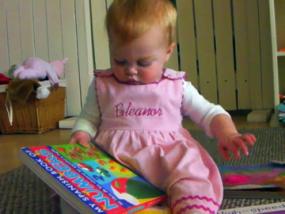What Is a Book Anyway?

Young children will understand a book, as a cultural artifact, at different levels. We might call these early levels a form of pre-literacy. Is a book an interestingly hinged object to fold open and shut or pages that carry information in a sequence? Are the color patterns pretty decorations or pictures that refer to real things? Does the cover of a book have a different purpose than the inside of the book?
What actions do we look for to answer some of these questions? This clip shows two children at slightly different levels of treating a book as more than a physical object. The young girl finds the side of the book that allows her to pry it open. She does not try to pry it open from the spine. Notice how she lifts the open book toward her face and utters a sound (00:09). Is this sound an imitation of what she has seen others do, or is she expressing her recognition of a picture? Her line of gaze seems to be directed more at the blue on the page of print. As she continues to open pages she takes less and less time to process what is printed on the pages. As she switches to a second book we credit her again with knowing how to search for the side that opens. But instead of studying the pictures on the page, she tries to lift an edge with her thumb (00:26). She works to turn the pages and even over-applies this goal when she gets to the picture glued to the front of the book (00:52). When this picture resists folding over she reverses her strategy and folds the adjacent page toward the front (01:00). We can credit her with knowing how a book works as a physical object, but we have little reason to conclude that she is thinking that a book carries information. The teacher captions the picture, “a duck.” This labeling of the pictures will eventually help the child treat books as a source of information.
The young boy’s actions are rather different. He opens a new page, pauses, and looks at the pictures for a few seconds. Notice that at 02:16, when he sees the picture of a gorilla, he recognizes that the same picture appears on the cover. He flips the pages to reveal the cover, confirming his observation. He leaves his thumb in the place he left, perhaps as a way to more easily return to the interior page containing the gorilla’s picture.
He makes some vocalizations that are punctuated to match the full opening of a new page, as if he knows that this is what you do to introduce new information on a new page. He goes both forward and backward through the book, so he probably does not know that pages are turned from right to left for a reason. Each new page has something new to see and study, but he does not value the sequence. When he finishes turning all the pages from back to front, he goes back the other way. But he does not try to turn just one page at a time(03:14) as he did when he went from back to front. Perhaps he simply does not want to miss viewing any of the pictures. It is unlikely that he knows that a story has a sequence.
The early strategies described above are more than imitations to be forgotten as the child learns to read. They are components of the conventions that make books work: searching for the edge that is not hinged; turning one page at a time; turning from front to back only; pausing to scan the visual patterns on the page; treating the cover as a clue for the contents, and eventually using the sequence of the pages as relevant to the meaning of the presentation.
Run time 4 minutes 2 seconds
